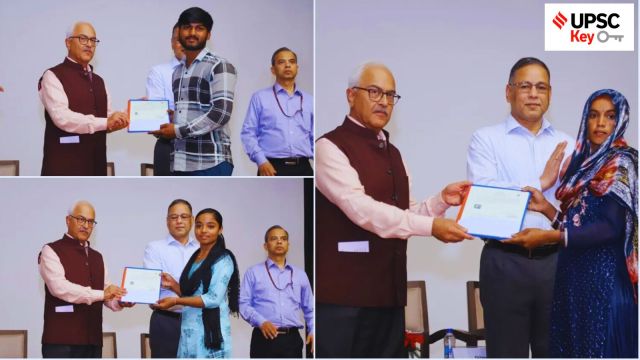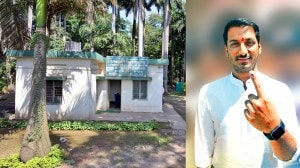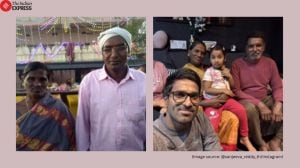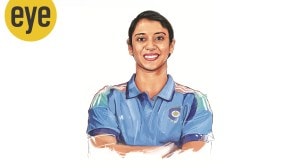🚨 The Indian Express UPSC Essentials brings to you the May edition of its monthly magazine. Click Here to read. Share your views and suggestions in the comment box or at manas.srivastava@indianexpress.com🚨
Explained Network
UPSC Syllabus:
Story continues below this ad
Preliminary Examination: Indian Polity and Governance-Constitution, Political System, Panchayati Raj, Public Policy, Rights Issues, etc.
Mains Examination: GS-II: Indian Constitution—historical underpinnings, evolution, features, amendments, significant provisions.
What’s the ongoing story- Two months after the Union Ministry of Home Affairs (MHA) notified the rules for implementation of the Citizenship (Amendment) Act, which was enacted by Parliament in December 2019, Union Home Secretary Ajay Bhalla on Wednesday physically handed over the first set of citizenship certificates to 14 applicants.
Prerequisites:
— What is the Citizenship Amendment Act (CAA), 2019?
— What are the Citizenship related provisions in the Indian Constitution?
Story continues below this ad
— Citizens and Aliens-compare and contrast in terms of civil and political rights
Key takeaways:
— According to the MHA, many other applicants are being given digitally signed certificates through email.
— The Citizenship (Amendment) Bill, which sought to fast-track the process of granting Indian citizenship to Hindus, Sikhs, Buddhists, Jains, Parsis and Christians—but not Muslims—who migrated to India owing to religious persecution in Pakistan, Afghanistan and Bangladesh, was passed by the Lok Sabha on December 9, 2019, and the Rajya Sabha two days later. It received the President’s assent on December 12, 2019. The Centre had notified Citizenship (Amendment) Rules, 2024 on March 11.
Points to Ponder:
— What are the ways of acquiring and losing citizenship under The Citizenship Act of 1955?
Story continues below this ad
— What are the issues and challenges with Citizenship (Amendment) Act (CAA)?
— What are those rights and privileges that the Constitution of India confers on the citizens of India and denies the same to aliens?
— What is the difference between NRC, NPR, and CAA?
Post Read Question:
With reference to India, consider the following statements: (UPSC CSE 2021)
1. There is only one citizenship and one domicile.
2. A citizen by birth only can become the Head of State.
Story continues below this ad
3. A foreigner once granted citizenship cannot be deprived of it under any circumstances.
Which of the statements given above is/are correct?
(a) 1 only
(b) 2 only
(c) 1 and 3 only
(d) 2 and 3 only
Other Important Articles Covering the same topic:
Explained: What is Citizenship Amendment Act?
UPSC Syllabus:
Preliminary Examination: Indian Polity and Governance- Constitution, Rights Issues.
Mains Examination: GS-II: Government policies and interventions, Issues relating to Health.
What’s the ongoing story- The Supreme Court on Wednesday rejected a prayer to allow abortion of a 27-week pregnancy while observing that the foetus too has a right to live.
Prerequisites:
Story continues below this ad
— What are the Medical Termination of Pregnancy Act, 1971 and MTP Amendment Act 2021?
— What are the key provisions of the MTP Act, 1971?
Key takeaways:
— A bench of Justices B R Gavai, S V N Bhatti and Sandeep Mehta told the counsel appearing for the 20-year-old single woman that the pregnancy was in excess of seven months now and asked “what about the right of the child to survive? How do you address that?”.
— The counsel told the court that the Medical Termination of Pregnancy Act primarily laid stress on the rights of the mother and that she is in a very delicate state.
— Last month, an SC bench presided by Chief Justice of India D Y Chandrachud had allowed a 14-year-old minor rape victim to terminate her 27-28 week pregnancy terming it a “very, very exceptional case where we have to protect her”. The court, however, recalled the order two weeks later as her mother who initially was for the abortion, expressed doubts over the likely impact of the procedure on her daughter’s health and opted to have a normal delivery.
Story continues below this ad
— The CJI led bench also said that a “medical board, in forming its opinion on the termination of pregnancies must…also evaluate the physical and emotional wellbeing of the person in terms of the judgment”.
Points to Ponder:
— What do you understand by the test of “foetal viability”?
— What are abortion laws in India?
— What is the significance of the Justice K.S. Puttaswamy (Retd.) vs. the Union of India and Others (2017) judgment regarding women’s reproductive rights?
— What are the global abortion laws?
Post Read Question:
Is there a question of ‘foetal viability’ in abortion in India, and do the rights of an unborn child matter in the same way as in many jurisdictions abroad?
Other Important Articles Covering the same topic:
What is India’s abortion law?
Story continues below this ad
What is ‘foetal viability’ in abortion, and do the rights of an unborn child matter?
Front Page
UPSC Syllabus:
Preliminary Examination: Indian Polity and Governance
Mains Examination: GS-III: Various Security forces and agencies and their mandate.
What’s the ongoing story- Arrested on October 3 last year after the Delhi Police Special Cell conducted searches across Delhi-NCR and Mumbai on the premises of journalists, technicians and contributors associated with the news portal, Purkayastha walked out of Tihar Jail hours after the Supreme Court order.
Prerequisites:
— What is the Unlawful Activities (Prevention) Act (UAPA)?
— What are Articles 20, 21, and 22 of the Indian constitution?
— What is due process of law?
Story continues below this ad
— What is the Pankaj Bansal versus Union of India case?
— What is PMLA?
Key takeaways:
— The Supreme Court on Wednesday declared the arrest and subsequent remand of NewsClick web portal founder-editor Prabir Purkayastha under the Unlawful Activities (Prevention) Act as “invalid” and ordered his immediate release.
— The SC underlined that any person arrested for any offence “has a fundamental and a statutory right to be informed about the grounds of arrest in writing and a copy of such written grounds of arrest have to be furnished to the arrested person as a matter of course and without exception at the earliest.”
— Expanding the scope of its October 3, 2023 ruling in the Pankaj Bansal vs Union of India case wherein it said that the Enforcement Directorate (ED) should furnish the grounds of arrest under the Prevention of Money Laundering Act (PMLA) in writing to an accused at the time of arrest, the bench said this should apply to arrest for all offences.
— Article 22 (1) of the Constitution says “no person who is arrested shall be detained in custody without being informed, as soon as may be, of the grounds for such arrest nor shall he be denied the right to consult, and to be defended by, a legal practitioner of his choice”.
— It said “the Right to Life and Personal Liberty is the most sacrosanct fundamental right guaranteed under Articles 20, 21 and 22 of the Constitution” and “any attempt to violate such fundamental right… would have to be dealt with strictly”.
— It said “There is a significant difference in the phrase ‘reasons for arrest’ and ‘grounds of arrest’…”
For Your Information:
— Extending procedural safeguards to UAPA is crucial as the law gives the state-wide powers– from relaxing timelines for the state to file chargesheets and its stringent conditions for bail — compared to the Indian Penal Code.
— The Pankaj Bansal case was regarding a money laundering offense under the Prevention of Money Laundering Act (PMLA), the UAPA to contains a similar provision, which requires the grounds of arrest to be presented. Since both laws are comparable, the ruling would also be deemed applicable to UAPA.
Points to Ponder:
— How proper procedure and due process are the guardrails against arbitrary action?
— What are the concerns regarding the UAPA?
— What was the need to enact UAPA?
— What are the provisions of bail under UAPA?
Post Read Question:
Indian Government has recently strengthened the anti-terrorism laws by amending the unlawful Activities (Prevention) Act (UAPA), 1967 and the NIA act. Analyze the changes in the context of prevailing security environment while discussing the scope and reasons for opposing the UAPA by human rights organizations. (UPSC CSE 2019)
Other Important Articles Covering the same topic:
Failure to follow procedure: Why SC said Newsclick founder’s arrest was illegal
The Editorial Page
UPSC Syllabus:
Preliminary Examination: Economic and Social Development
Mains Examination: GS-III: Capital markets.
What’s the ongoing story- In recent years, there has been a surge in stock market participation in India. At the end of 2018-19, the number of demat accounts in the country stood at 3.59 crore. By October 2021, the figure had risen to 7.38 crore and as per more recent reports, there are now more than 15 crore demat accounts.
Prerequisites:
— Who regulates the Stock market?
— What is futures and options (F&O) trading?
— What is the purpose of the Stock Exchange?
Key takeaways:
— According to data from the Association of Mutual Funds in India, investments just through the SIP route (systematic investment plan) stood at Rs 1.99 lakh crore in 2023-24, more than doubling from Rs 92,693 crore in 2018-19. All this points towards a spreading culture of equity.
— But, alongside this growing participation by households in stock markets, there are concerns over the sharp surge in trading in futures and options (F&O) by retail investors.
— In 2023, according to a study by the Securities and Exchange Board of India, the number of unique traders in the F&O segment had risen to 45.2 lakh in 2021-22, up from 7.1 lakh in 2018-19.
— What was equally revealing was that 89 percent of the traders incurred losses while trading in the F&O segment. The average loss was pegged at around Rs 1.1 lakh.
— In 2023, a report titled “Gamification of Indian equities” by Axis Mutual Fund estimated the derivatives to cash volume ratio in India at 422. In comparison, the ratio was 36 in the case of Germany and nine for the US.
Points to Ponder:
— What are the major stock exchanges in India?
— How does the stock exchange work?
— What is the role of SEBI in regulating stock exchanges in India?
— What steps need to be taken to educate investors about the risks and benefits associated with the stock market?
Post Read Question:
Prelims
In the context of finance, the term ‘beta’ refers to (UPSC CSE 2023)
(a) the process of simultaneous buying and selling of an asset from different platforms
(b) an investment strategy of a portfolio manager to balance risk versus reward
(c) a type of systemic risk that arises where perfect hedging is not possible
(d) a numeric value that measures the fluctuations of a stock to changes in the overall stock market
Mains
The gamification of investing has led to an increase in stock market investments. However, it also poses potential risks, as seen in the suspension of Robinhood, a US brokerage. Examine.
UPSC Syllabus:
Preliminary Examination: Current events of national importance, Indian Polity and Governance.
Mains Examination: GS-II, GS-III: Government Policies & Interventions, Various Security Forces & Agencies & their Mandate Security Challenges & their Management in Border Areas.
What’s the ongoing story- C. Uday Bhaskar writes- “Media reports suggest (‘Armed Forces’ integrated commands structure plan looks at Vice CDS, Dy CDS with clear roles’, IE, May 13) that the complex and contentious policy issue of rewiring the Indian military into integrated theatre commands (ITC) is gaining traction and that the armed forces are looking at the appointment of a Vice Chief of Defence Staff and a Deputy Chief of Defence Staff.”
Prerequisites:
— What is Chief of Defence Staff (CDS)?
— Chiefs of Staff Committee (COSC) and Chief of Defence Staff- Compare and Contrast.
— What are integrated theatre commands?
Key takeaways:
— “Wearing three hats, the CDS is the first among equals along with the other three service chiefs as a four-star general. Concurrently, he is Secretary to the Government of India in the Ministry of Defence and Principal Adviser to the Defence Minister on inter-service issues.”
— General Bipin Rawat, who retired as the army chief in December 2019, was appointed as the first CDS in January 2020. General Rawat died in an unfortunate air accident in December 2021. In October 2022, Lt Gen Anil Chauhan (retd) was appointed the second CDS.
— “New posts at the higher level are being envisaged to enable the CDS to realise the larger objective of enhancing jointness (the sharing of domain expertise and assets) and improving composite combat capability.”
— “The first pertains to the post of a Vice CDS in four-star rank. Rank hierarchy is central to the military and if implemented, the office of the CDS would be tenanted by two four-star rank officers and at a later stage — complemented by three theatre commanders presumably of four-star rank. Concurrently, the three service chiefs who are the original four-star rank officers would have a different profile that would be devoid of the command responsibility.”
— “The creation of the CDS in 2019 was to enable an enhancement in overall combat efficiency across the board and prepare for new exigencies that will be shaped by the techno-strategic churn that is now taking place.”
Points to Ponder:
— What is the role of CDS?
— What is the significance of CDS?
— What are the recent reforms taken in the Indian defence system?
Post Read Question:
Border management is a complex task due to difficult terrain and hostile relations with some countries. Elucidate the challenges and strategies for effective border management. (UPSC CSE 2016)
Other Important Articles Covering the same topic:
Armed Forces’ integrated commands structure plan looks at Vice CDS, Dy CDS with clear roles
UPSC Syllabus:
Preliminary Examination: Current events of national and international importance
Mains Examination: GS-II: Issues relating to development and management of Social Sector/Services relating to Health, Government policies and interventions
What’s the ongoing story- It’s well-known that spotting signs of cancer at an early stage significantly increases the possibilities of surviving the disease. In India, government projects, including the National Programme for the Prevention and Control of Cancer, Diabetes, Cardiovascular Disease and Stroke, recognise this necessity.
Prerequisites:
— What is the Ayushman Bharat Pradhan Mantri Jan Arogya Yojana (AB-PMJAY)?
— Who are ASHA workers?
Key takeaways:
— National Family Health Surveys have revealed that a very small percentage of people in the vulnerable age group — those over 30 years of age — get screened for malignancy.
— Turning 1,50,000 health and wellness centres (HWCs) into nodal points for cancer detection under the Ayushman Bharat Pradhan Mantri Jan Arogya Yojana (AB-PMJAY) could have proved to be a game changer.
— A Niti Aayog report has flagged “huge gaps” in the performance of these HWCs. Less than 10 per cent of these centres had completed one round of screening for non-communicable diseases, including cancer, says the report.
— In recent years, India has done well in piloting low-tech approaches to cancer screening that can be delivered at scale by community-level workers. AB-PMJAY makes use of these technologies. Global experience shows that the trust enjoyed by grassroots-level professionals is a big positive when it comes to screening people for diseases that may not show any symptoms. — The government, therefore, did the right thing in roping in ASHA workers in its project. However, it does not seem to have invested adequately in the next steps.
— Given the low awareness of the disease, it was imperative that these frontline professionals were educated about cancer prevention protocols and trained to use the screening techniques.
For Your Information:
— According to Dr Abhishek Shankar, Cancer has become a public health concern in India and has touched most families. In spite of the best efforts, most cancers are diagnosed at advanced stages leading to adverse outcomes. There is growing evidence about the proven role of preventive strategies to minimise the risk of cancer and screening methods to detect cancer at an early stage for better survival.
Points to Ponder:
— Why cancer cases are increasing in India?
— What necessary steps need to be taken?
— What is the significance of early detection of cancer?
— What are the initiatives for cancer treatment and prvention in India?
(Thought Process: Mention about the government initives– incorporate new edge technology in cancer detection and treatment–CAR-T cell therapy, First cancer care initives, NPCDCS…)
Post Read Question:
Prelims
‘RNA interference (RNAi)’ technology has gained popularity in the last few years. Why? (UPSC CSE 2019)
1. It is used in developing gene silencing therapies.
2. It can be used in developing therapies for the treatment of cancer.
3. It can be used to develop hormone replacement therapies.
4. It can be used to produce crop plants that are resistant to viral pathogens.
Select the correct answer using the code given below.
(a) 1, 2 and 4
(b) 2 and 3
(c) 1 and 3
(d) 1 and 4 only
Mains
What are the challenges faced by Healthcare Providers in curing cancer? What steps need to be taken?
Other Important Articles Covering the same topic:
Niti Aayog report finds ‘huge gap’ in cancer screening at Ayushman centres
Why are cancer cases soaring in India?
Explained
UPSC Syllabus:
Preliminary Examination: Indian Polity and Governance
Mains Examination: GS-II: Polity
What’s the ongoing story- During the ongoing Lok Sabha elections, 96.8 crore electors are enrolled to vote at 10.5 lakh polling stations spread out nationwide, from the heart of bustling metropolises to the most remote corners of the country. Here is how India’s polling stations work.
Prerequisites:
— What is the Representation of the People Act, 1951 (RPA)?
— How elections are conducted in India?
— What is Saksham app?
— What is the role of the Election Commission?
Key takeaways:
— How are polling stations set up?: Under Section 25 of the Representation of the People Act, 1951 (RPA), the district election officer (DEO) is assigned the responsibility to set up and publish the list of polling stations in their district.
— Layout and some facilities: There are separate entrance and exit points for voters, even if only one door is available. A comprehensive gap analysis is conducted before elections to ensure the provision of Assured Minimum Facilities (AMF) at each polling station, which ensures smooth voting experiences and efficient polling personnel duties.
— Who is permitted inside polling stations?: Only specific individuals are permitted access inside a polling station. These include registered electors, polling officers… and any others admitted by the Presiding Officer for voter identification or assistance purposes, whenever required.
— Critical polling stations: Critical polling stations are those where the ECI takes some extra measures to ensure the security and integrity of the voting process. These include ones in vulnerable areas, areas with abnormal law & order situations, those with unusually high ( over 90%, with over 75% votes polled in favour of one candidate), or low ( under 10%) voter turnout rates.
For Your Information:
— The Kesavananda Bharati v State of Kerala (1973) judgment held that free and fair elections form part of the basic structure of the Constitution.
— Three essential ingredients constitute free and fair elections: A level playing field for political campaigning, an independent umpire to oversee the process and a fair regulatory framework or rules of the game.
Points to Ponder:
— What Election Commission can do if normal polling process is disrupted?
— What steps have been taken by the ECs to facilitate voting for Persons with Disabilities (PwD)?
— What are the constitutional provisions related to elections in India?
Post Read Question:
Who is assigned the responsibility of setting up polling stations in the district under the RPA, 1951?
(a) Presiding Officer
(b) District Election Officer
(c) Booth Level Officer
(d) Polling Officer
Other Important Articles Covering the same topic:
Experts Explain: Last 72 hours most crucial during elections, here’s what happens behind the scenes
Expert Explains: What Election Commission can do if normal polling process is disrupted
Economy
UPSC Syllabus:
Preliminary Examination: Current events of national importance
Mains Examination: GS-II, GS-III: Issues Relating to development and management of Social Sector/Services relating to Health.
What’s the ongoing story- India has made the testing and sampling of Ethylene Oxide (EtO) residue for all spice shipments to Singapore and Hong Kong from May 7 mandatory, the commerce and industry ministry said on Wednesday.
Prerequisites:
— What is ethylene oxide?
— Read about the FSSAI, Spice Board India.
Key takeaways:
— Hong Kong on April 5 banned four products of Indian manufacturers in the country citing presence of pesticide, ethylene oxide.
— EtO is a fumigant type of product that is used during transportation and that some amount of pesticide is allowed in the process of food management. Different countries also have prescribed varying limits of chemicals that can be present in food.
— A government official said that rejection rates of spices are low and that export sample failures are one off in nature. “The rejection rate of spices is less than 1 per cent of the total quantity exported by us to major jurisdictions. India exported about 14.15 million tonne of spices in FY24 and 200 kg is a small quantity that has been recalled,” a commerce ministry official said.
Points to Ponder:
— How can ethylene oxide impact health?
— Where else is ethylene oxide banned?
— What are the challenges associated with the food safety in India?
— What are some of the important initiatives for food safety in India?
— What is the State Food Safety Index (SFSI)?
Post Read Question:
Consider the following statements with regard to ethylene oxide?
1. It is a colourless, highly flammable and very reactive gas that kills bacteria and viruses only.
2. It is a pesticide that has been classified as a Group 1 carcinogen.
How many of the statements given above are correct?
(a) 1 only
(b) 2 only
(c) Both 1 and 2
(d) None
Other Important Articles Covering the same topic:
UPSC Issue at a Glance | Food Safety : 5 Key Questions You Must Know for Prelims and Mains
Ethylene Oxide
The World
China to Pak: Do your ‘utmost’ to protect Chinese workers from terror attacks
UPSC Syllabus:
Preliminary Examination: Current events of national and international importance.
Mains Examination: GS-II: Bilateral, regional and global groupings and agreements involving India and/or affecting India’s Interests, India and its neighbourhood- relations
What’s the ongoing story- China on Wednesday asked Pakistan to do its ‘utmost’ to protect thousands of Chinese workers involved in the CPEC projects as the two countries held strategic dialogue here amid serious economic crisis in Pakistan and Beijing’s concerns over increasing attacks on its citizens in the country.
Prerequisites:
— What is China-Pakistan Economic Corridor (CPEC)?
— What is the purpose, objective and goal of the CPEC?
— Map Work- China-Pakistan Economic Corridor, Belt and Road Initiative (BRI), Dasu Hydropower Project, Khyber Pakhtunkhwa Province.
Key takeaways:
— Pakistan’s Deputy Prime Minister and Foreign Minister Ishaq Dar, who is in China on a four-day visit, and Chinese Foreign Minister Wang Yi co-chaired the fifth round of the Foreign Minister-Level China-Pakistan Strategic Dialogue.
— The recurring attacks on the Chinese personnel working in the USD 60 billion CPEC projects by militant groups in Pakistan has become a major concern for China.
Points to Ponder:
— How CPEC is affecting India’s sovereignty and territorial integrity?
— CPEC and Belt and Road Initiative (BRI)-How these two are related?
— How many countries are part of BRI?
— India-Pakistan bilateral relations, India-China bilateral relations- Know in detail the points of cooperation and conflict.
Post Read Question:
Prelims
Belt and Road Initiative’ is sometimes mentioned in the news in the context of the affairs of (UPSC CSE 2016)
(a) African Union
(b) Brazil
(c) European Union
(d) China
Mains
The China-Pakistan Economic Corridor (CPEC) is viewed as a cardinal subset of China’s larger ‘One Belt One Road’ initiative. Give a brief description of CPEC and enumerate the reasons why India has distanced itself from the same. ( UPSC CSE 2018)
Other Important Articles Covering the same topic:
China-Pakistan Economic Corridor: Pakistan’s road of high hopes
Subscribe to our UPSC newsletter and stay updated with the news cues from the past week.
https://www.youtube.com/watch?v=wsnxUastCeM?si=zLocEHO2r_7Dje-0



































